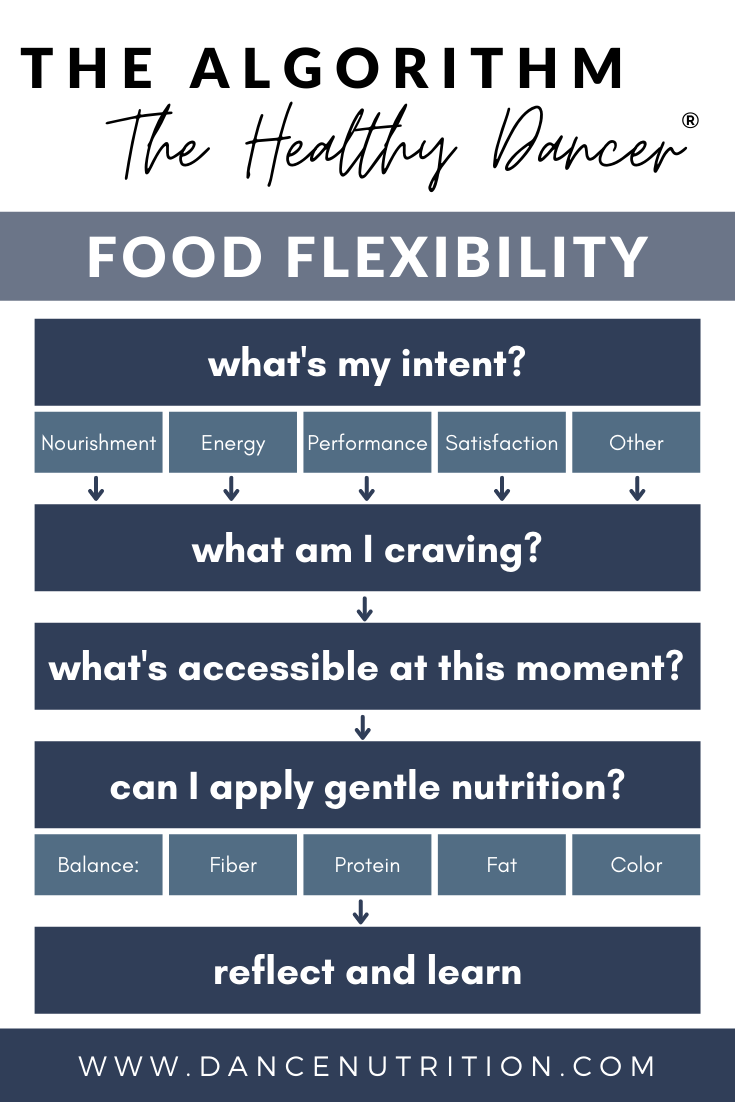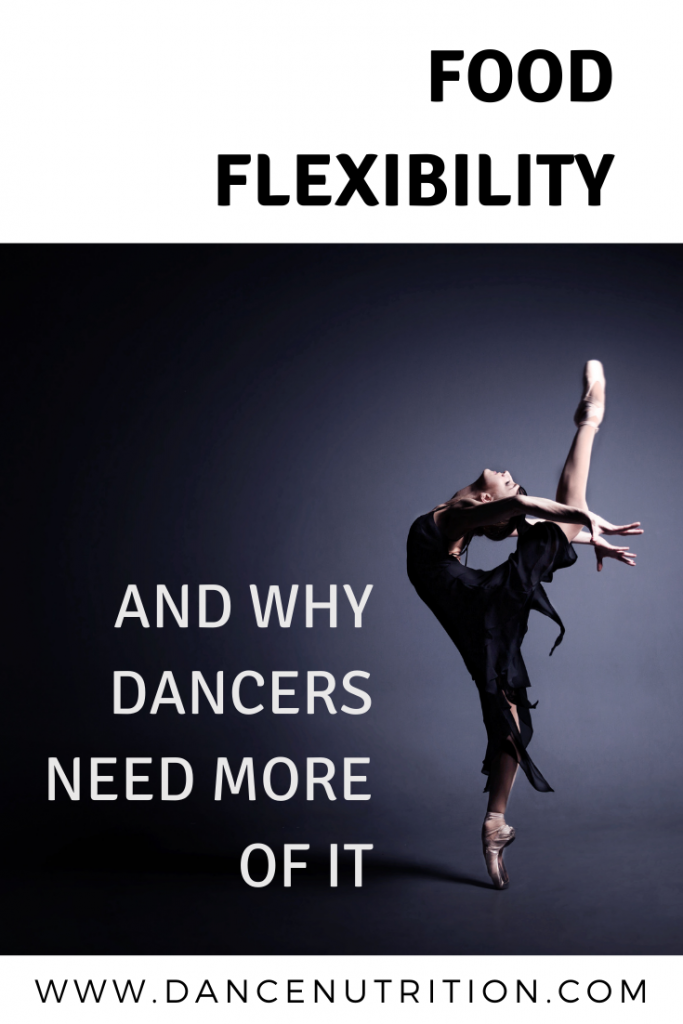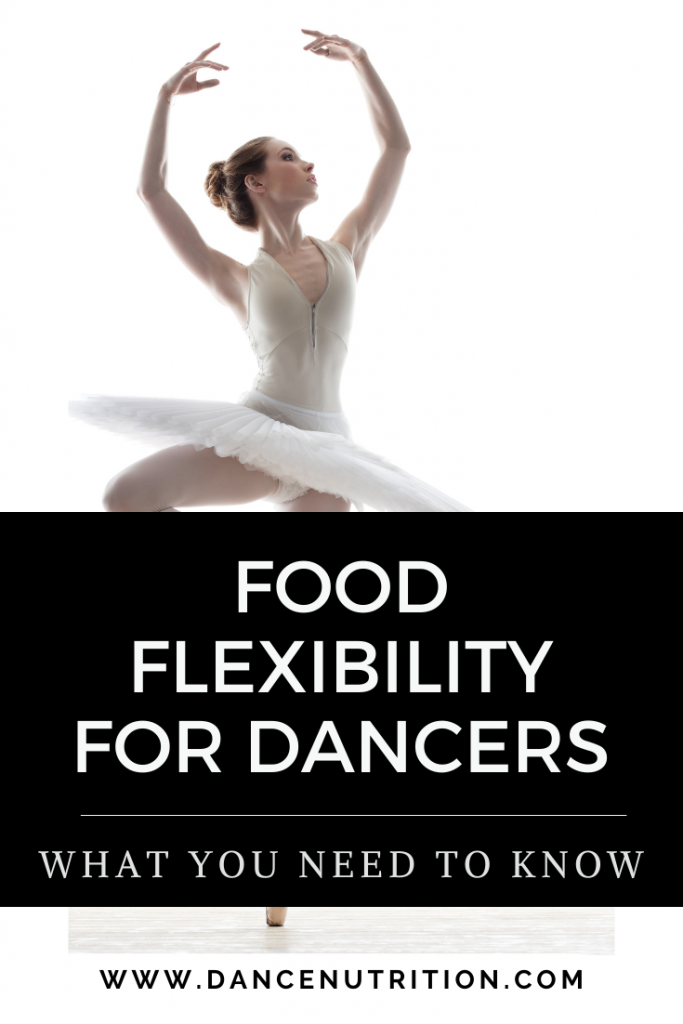Food Flexibility allows dancers to adapt to an ever-changing food environment. The more flexible you are with your food choices, the more you’ll be able to move through life’s experiences with ease and without stress.
For many dancers, however, food flexibility isn’t straightforward. Too frequently, dancer diet culture encourages a rigid approach, emphasizing “clean” eating as key to health, performance, and the pursuit of unrealistic body standards. This mindset puts dancers at significant risk for eating disorders and disordered eating, both of which can negatively impact career success.
Dieting and Food Inflexibility
Whether you’re attempting a traditional diet like paleo or keto, or looking to eliminate overly processed foods, chances are you’re relying on a set of rules to determine your next meal or snack. Even with the best of intentions, these food rules can easily become unattainable— especially for dancers who may not have full control over what’s available to eat.
Food inflexibility makes it difficult to break these rules, evoking food guilt and menu anxiety. With restrictive eating being the norm in today’s world, it can be tough to identify food inflexibility. Clean eating is often a culprit, along with:
- Extreme anxiety about food or mealtimes.
- Overwhelming guilt after eating.
- Obsessive thoughts about food.
- Avoiding food you didn’t prepare yourself.
- Feeling out-of-control around food (compulsive or compensatory eating, binge eating)
- Inability to trust yourself around certain foods deemed “bad” or “unhealthy.”
Why Is Food Flexibility Hard for Dancers?
Daily reminders of what’s “healthy” versus what’s “unhealthy,” or what’s “good” versus what’s “bad,” can make it incredibly difficult to move past restrictive patterns. Here are some of the primary challenges that make it difficult for dancers to sustain a flexible eating routine:
- Perfectionism – Dancers tend to be perfectionists, increasing their vulnerability to orthorexic behaviors.
- Overexposure to misinformation – Dancers are often surrounded by conflicting and misleading information about food and body image, even from well-meaning teachers and directors.
- Blunted hunger cues – High levels of physical activity can dull hunger signals, leading dancers to unintentionally under-fuel.
- Busy schedules – Dancers often have hectic routines that shift their focus away from meeting their fueling needs.
- Unrealistic body ideals – Many dancers mistakenly believe that controlling food intake is the key to controlling body weight and improving performance.
Building A Food-Flexible Mindset
Food flexibility requires an overhaul of nutrition misinformation— dismantling the many messages from diet culture that led to feeling doubtful, guilty, and stressed when eating. Only then can we truly relearn how to support our bodies with curiosity and compassion, rather than judgment and guilt.
The Healthy Dancer® Food Flexibility Algorithm
The Healthy Dancer® Food Flexibility Algorithm is a guided approach used to help food decisions. It begins by identifying your intent— why you are eating and what your goals are for fueling your body. Once your intent is clear, take a moment to consider what foods are accessible to you and what you prefer, ensuring that your choices align with both availability and taste. You’ll need to explore the “shoulds” and “shouldn’ts” we’ve internalized about food. The key here is food neutrality: seeing food for what it truly is— fuel for your body and enjoyment for your soul.
From there, apply the principles of gentle nutrition, focusing on balance and consistency to help you make informed, not obsessive, food choices.To learn more about gentle nutrition, read this article. Remember that busy schedules and high levels of physical activity can diminish hunger cues. You may need to take a look at this article, which dives into a dancer’s calorie needs.
Lastly, reflect on the experience— ask yourself, did the meal leave you feeling energized and satisfied? Use this reflection to refine and learn from each eating experience. Practices like mindful eating can help you identify types and amounts of food that leave you feeling good. If you’re concerned about overeating, learn how to stop when you’re full by reading this article.
15+ Real-Life Examples of A Food-Flexible Mindset:
- Airport Meal: If you’re traveling for a competition or performance and only have access to convenience foods, you grab a pre-made sandwich but choose a water or smoothie over soda to stay hydrated.
- Airport Snack on Layover: Your flight is delayed, and you’re stuck at the airport with limited options, but you choose a whole-wheat sandwich with turkey and add a small salad or apple for some fiber. Pair it with the complimentary cookie!
- Hotel Breakfast: Staying at a hotel with a complimentary breakfast? You opt for the bagel but add a side of yogurt or scrambled eggs for a protein boost.
- Hotel Room Snack: You have limited options in your hotel room, so you opt for an apple and peanut butter M&M’s.
- Fast Food Drive-Thru: On the road, you choose nuggets and fries but add a side salad to get some veggies in.
- Packing Snacks for Class: Instead of just grabbing a granola bar, you pack a small bag with nuts and dried fruit.
- Cafeteria Lunch: At a competition with limited options, you opts for a chicken salad sandwich, making the best of what’s available, and supplementing it with a snack of nuts and fruit.
- Festival Food Trucks: At a dance festival, you order a healthy smoothie bowl and enjoy it with a side of sweet potato fries for a mix of nutrients and comfort.
- Late-Night Snack After Rehearsal: You’re starving after a late-night rehearsal, so you make a quick meal with whatever’s available in your fridge— like scrambled eggs with a side of toast and fruit.
- Post-Performance Snack: After a long day of rehearsals or a performance, you enjoy a sundae with friends and plan for a balanced recovery meal once home.
- Performance After-Party: the food spread includes pizza, cookies, and chips. Instead of feeling stressed or guilty, you enjoy a slice of pizza and a cookie, knowing you can balance it out in the days to come.
- Grocery Store Stop: You’re staying in an Airbnb, so you stop by a grocery store to pick up pre-cooked chicken, cheese, some fruit, and a fresh roll for a quick, balanced meal.
- Fueling for Early Morning Classes: You’re running late but quickly grab a banana and a spoonful of peanut butter, paired with a croissant and latte from your local bakery.
- Dance Studio Vending Machine: During a long break between rehearsals, you eat your packed snack but enjoy part of a chocolate bar from the vending machine alongside it because you’re craving something sweet.
- Dining Out: You’re at a restaurant with friends, and instead of obsessing over the menu, you choose a meal that suits your mood— perhaps pasta with a side of veggies and chicken, and you enjoy dessert to satisfy your cravings.
Key Takeaways: Food Flexibility
Whether you’re new to The Healthy Dancer® or have been following for a while, you’ll quickly realize that it’s not just a no-diet zone— it’s also an anti-diet zone. Instead of rigid food rules, we embrace food choices rooted in nutrition science and pleasure. My goal is to empower dancers to thrive as athletes and artists, without the negative effects of food restrictions, “clean” eating, and dieting.
If you’re struggling with this process, stay tuned— The Healthy Dancer® Food Flexibility Challenge kicks off every April, and I’d love to have you join us on this transformative journey!





